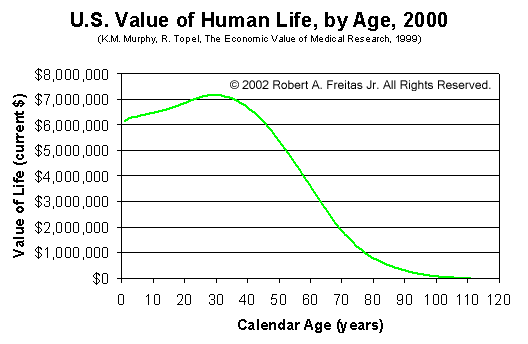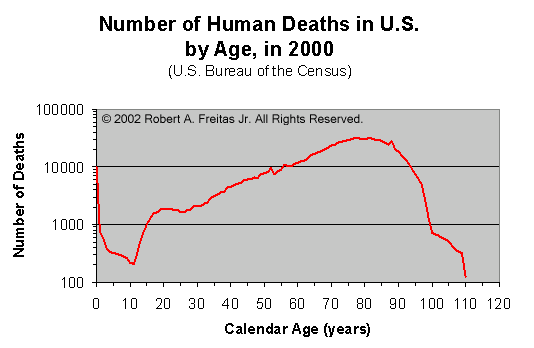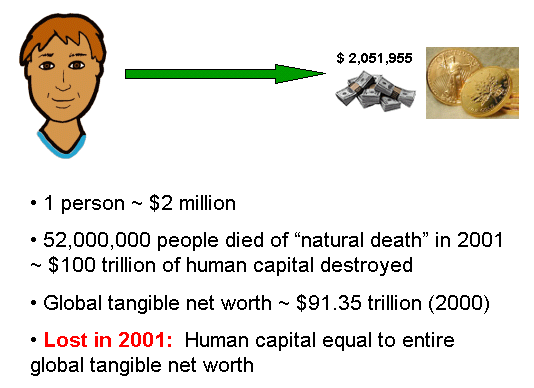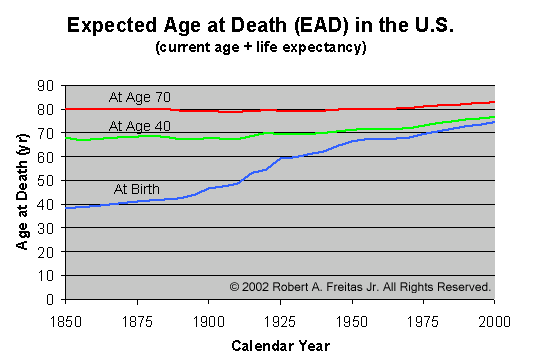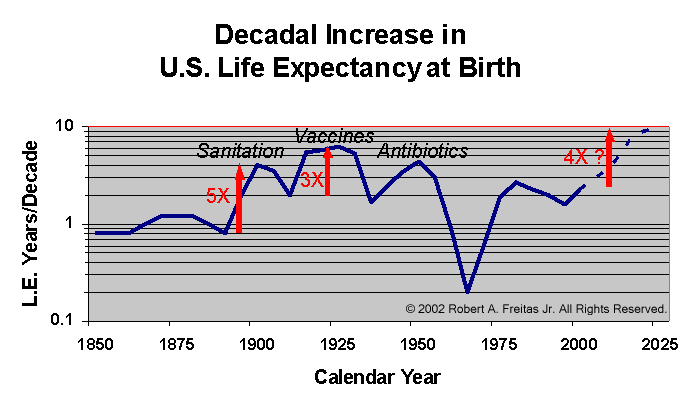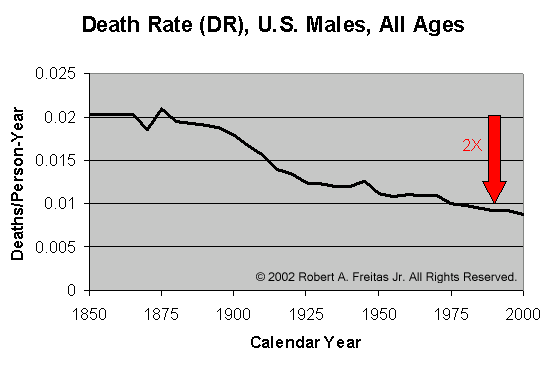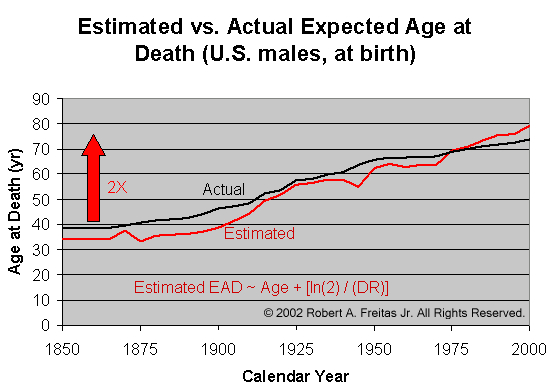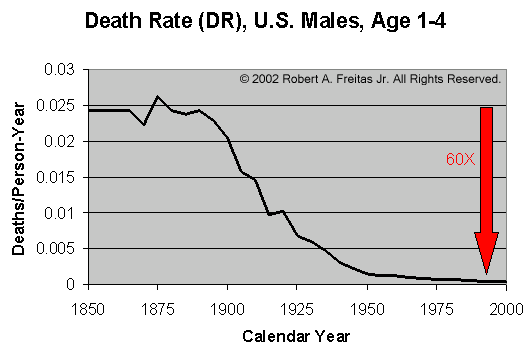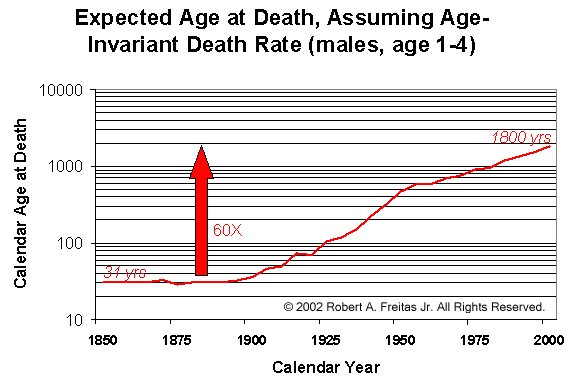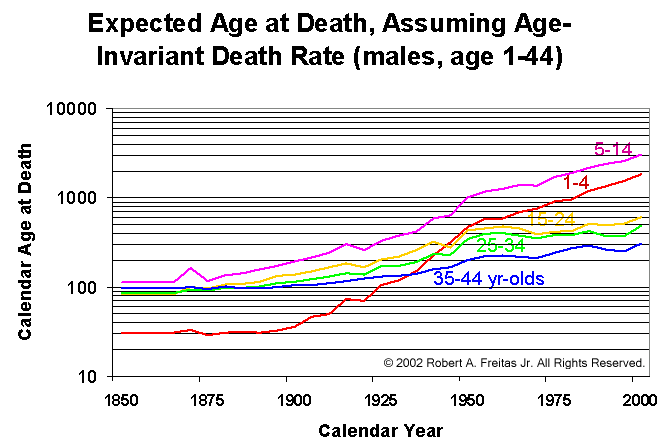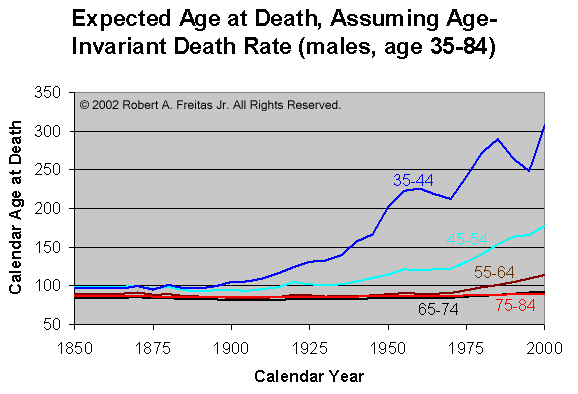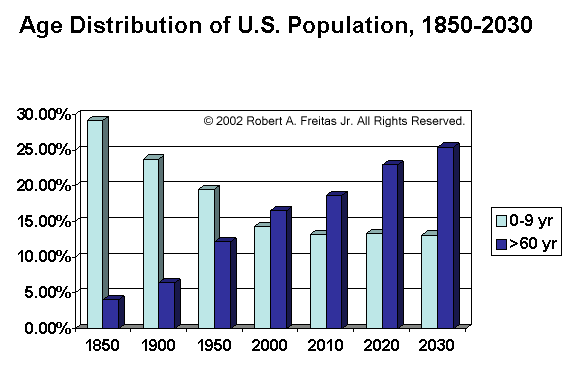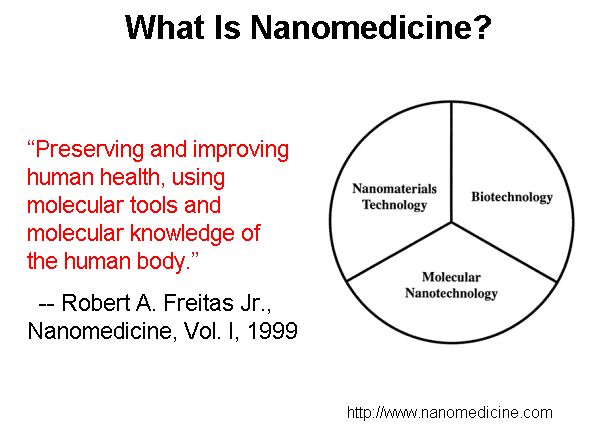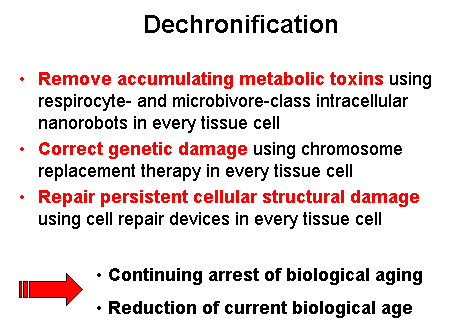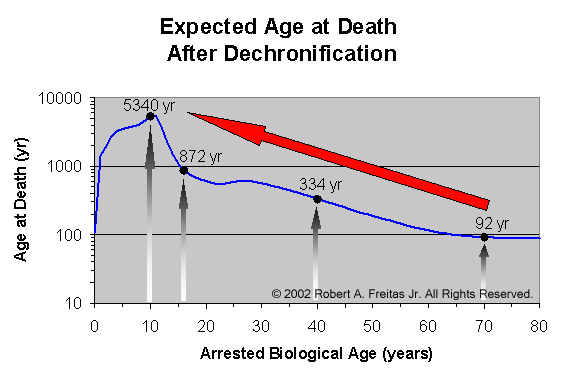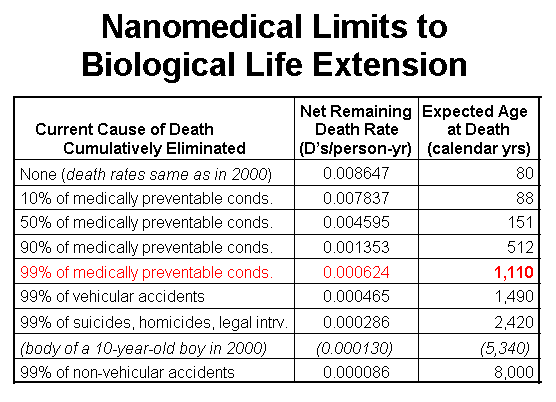Don't be put off by the title! Chris Phoenix, co-founder of the Center for Responsible Nanotechnology, has penned a very accessible primer on the role of tiny machines in the future of medicine. These are the technologies that we hope will keep us all healthy in years to come. This article first appeared as a chapter in "Doctor Tandy's First Guide To Life Extension And Transhumanity."
Copyright © Chris Phoenix.
Introduction
This chapter is not really about life extension. Instead, its focus is on health extension: keeping the body in a state of good health. This is a simpler topic, because we can ignore several philosophical questions. However, as the chapter unfolds, it will become clear that life extension is a natural consequence of health extension. As diseases are cured, causes of death will be avoided; as people make use of technology to improve their health, they will find themselves living longer--perhaps much longer.
A few thousand years ago, people lived about thirty years. From their point of view, we have already extended our lives to an amazing degree. However, from where we stand today, we can see that we still have a long way to go. Some people still die in their 40's from cancer, heart attack, stroke, and infections. This is tragic, and frustrating. Today's medicine is only somewhat able to deal with these and other conditions--and it has barely started to attack the problem of aging. But we can see light at the end of the tunnel.
Fifty years from now, what causes of death will be preventable? That depends largely on the technology we will have available, so let's start by projecting some technology trends. Gene sequencing and identification will be as easy as a blood sugar test. Medical devices such as artificial hearts and insulin pumps will be implantable and well-integrated with the body's natural demands. Surgical instruments will be more delicate and less destructive; what today is "major surgery" will be done with an office visit. Computers will be millions of times faster than today's machines. Last but not least, we will probably have the ability to build strong, useful, complex machines out of individual atoms and molecules. This is called "nanotechnology" or simply "nanotech", and it will make us healthier in several important ways.
Can we expect technology to solve all our medical problems? This chapter will answer that question by examining what nanotech can do for medicine. Nanotech is a huge topic, and medicine is even bigger, so this chapter can give only a sketchy overview. On the nanotech side, we will focus on robot-like machines with precise molecular parts; on the medicine side, we will limit ourselves to a mechanical view of medicine that mostly ignores the complexity that arises from all the body's systems working together. And I'll be remarkably unambitious (by future standards) in defining "good health": Good health is when the body is able to support typical activities without significant discomfort. (Optimum health is a matter of personal preference, and the chapter is long enough without getting into all the ways people could improve their bodies.) Even with these restrictions, it will become clear that nanotech can solve most or all of the medical problems that might keep us from being in good health, thus allowing us to remain in a state of good health for many decades or even centuries.
Background
Biology and Chaos
In order to be in good health, every system in the body (including the systems we haven't discovered yet) must be functioning well. Furthermore, the states of each system must be in sync with each other so that they will keep functioning well for a reasonable period of time. If the lungs are working faster than the muscles, the blood will gain too much oxygen and lose too much carbon dioxide, which will soon throw several systems off balance. But if all your systems are working well, and working together well, then your health will be good.
An automobile can be analyzed piece by piece. If the battery is dead, the headlights won't work; the burning gasoline pushes on the piston, which makes the wheels turn; and so on. A biological organism is not so simple. Frequently there is no clear boundary between the parts--one part may have several functions, and the whole system is in constant flux. A simple mechanical analysis will miss subtleties of operation. In fact, there is a whole new branch of mathematics called chaos that had to be invented to deal with systems like this.
You may have heard of the "butterfly effect"--a butterfly flapping its wings in China may create an air current that grows into a hurricane months later. A chaotic system, such as the weather or the human body, is inherently unpredictable: no matter how precisely you know its starting state, you can't tell what it will do in the future. (As we'll see later, most butterflies do not cause hurricanes--the point is that a single butterfly can sometimes make a big difference.) In fact, the body seems to depend on chaos. Normally the timing of the heartbeat is chaotic; if it ever becomes more regular, the person is about to have a heart attack. (References are at the end of this article.)
Suppose you wanted to study the body's response to exercise. You could look at the effect of blood oxygen level on breathing rate by making a graph with oxygen level on one axis and breathing rate on the other. Measure each quantity at one-minute intervals, plot the resulting points on the graph, and draw a line between successive points. If the relationship were perfectly simple, the graph would show a diagonal line: breathing rate would increase when oxygen level went down, and decrease as oxygen level recovered. In fact, because breathing affects oxygen level with some delay, the graph will show a cycle: first the oxygen decreases, then breathing increases, then oxygen increases, then breathing decreases, and around and around it goes. On the graph, this cycle would appear as an oval. Other factors would be deforming the shape. Over time, you would notice that the tracing crossed itself repeatedly. And you'd see something else: there would be more than one oval on the graph, representing states of waking, sleep, and so on, and the lines running from one oval to another would themselves be interestingly complex. If you did the experiment for years, you would find that all the lines stayed within a certain area of the graph: the breathing rate would never be above, say, 120 breaths per minute or below one breath every three minutes.
Now consider all the vast array of bodily mechanisms and substances. You could make a 3-D graph by adding insulin to your list of things to measure. But there are hundreds of hormones in the body, as well as other chemicals, temperature (core and extremity), bacterial counts, and physical conditions including scarring and posture. You would have to make a 300-D graph! If you could do such a thing, the shape on the graph would be vastly more complex than a few ovals. Even if you could make the graph, it's not clear how much you could learn from it--the graph covers so many possibilities, and the line you plot would be so small in comparison, that even several lifetimes of data could only explore a tiny fraction of the possible states. And don't forget that the body is chaotic: even if another body seemed to begin in a similar state, it would inevitably trace a different course through the graph.
If the body is chaotic, how can it keep functioning for years at a time in a changing environment? There is a mechanism called "homeostasis" that tends to pull things back to nominal levels. If the blood sugar gets too high, extra insulin is released. If the core temperature gets too low, blood vessels in the skin contract to save heat. But even with homeostasis, there are things that can go wrong if the body is pushed too far out of whack--vicious cycles the mechanisms of the body may enter. Medicine has named and studied many of them: diabetic coma, toxic shock, fibrillation, epilepsy, Cheyne-Stokes breathing, and death. Happily, many of these conditions are reversible with a big enough push in the right direction; the next section will explore the implications of that.
Medicine and Engineering
There is no doubt that an engineering approach to medicine is doomed to be incomplete. We will never know all there is to know about how the body works, and why it goes from one state to another. Nevertheless, medicine has been quite useful for some health problems, and is certain to become even more useful. The reason for the success is that, although the "butterfly effect" is real, most of the butterflies don't count--there are billions of butterflies but only a few hurricanes. Just as there are regions of instability where the smallest butterfly can create a storm cloud, there are regions of stability where even a bird won't cause much change. The fact that we can remain alive even for one day indicates that the homeostatic mechanisms of the body are usually able to keep it in the middle of the calm, "healthy" regions of the hypothetical graph. If every small change caused huge consequences, simply eating a meal would be terribly risky.
In fact, the body's ability to keep itself on track is quite powerful. Alcohol in large doses is a poison, but in slightly smaller quantities it causes only temporary and relatively mild effects. A person's blood sugar can vary by a factor of two or three without them even being aware of it. In rare cases, people have drowned for half an hour and been restored to life. People can be kept alive for hours with their heart and lungs disconnected during open-heart surgery, and if their kidneys fail, dialysis will work for years. Furthermore, the body constantly encounters and compensates for a wide variety of perturbations--depending on the physical demands a person faces, their food intake can vary from 1000 to 8000 calories per day.
If something does go seriously wrong, it can often be put right by a remarkably simple intervention. For example, a heartbeat is a delicately orchestrated ripple of activation that spreads from nerve centers through the heart muscle. When the ripples do not move smoothly (perhaps due to insufficient blood supply during a heart attack), different areas of the heart get out of sync and start to beat out of rhythm. This is called fibrillation, and it is generally fatal. But a single massive electric shock, enough to make the heart convulse in unison, is often enough to allow it to start beating normally (and yes, chaotically) again. That something as intricate as the heart can be restarted by such unsubtle treatment is evidence that the heartbeat is actually quite robust. Continuing the example of the graph, the shock has the effect of jolting the body back into a region of stability.
It seems, then, that a minor perturbation is quite unlikely to cause any disturbance in the body's overall state of health, and even major disturbances can often be tolerated. This is not to say that we can ignore the complexity and chaos inherent in the body. We will always have to be careful of unintended side effects. However, most well-designed treatments will not have any effects that are major, unexpected, and negative. As our medical technology improves, any negative effects will be either immediately noticeable or extremely slow and subtle, giving us plenty of opportunity to detect and correct them before they pose significant threats to health. And as we learn more about where the regions of stability are and how to push the body back to them, we will be able to apply simple "engineering fixes" to more and more problems.
We can assume, then, that medicine will generally be able to correct problems without creating worse problems. It will usually be the case that symptoms of sickness can be traced to improper status of particular systems, and those problems can be corrected using straightforward techniques without causing worse problems in other systems. This is not to say that an automobile-mechanic approach to health is always best--an "integrated" approach will work better for some problems. But the point of this chapter is that even a limited, mechanistic approach can result in greatly increased lifespan.
There are several types of systems in the body. The most obvious are physical systems, such as the bones and the lungs. The physical systems are coordinated by signaling systems--patterns of chemicals or of neural activity that provide control and feedback to the various organs and tissues. DNA can be considered a system whose main purpose is to store information; it interacts with many signaling systems to produce a wide range of proteins. Metabolic systems create and destroy chemicals in order to supply the body with energy and clean up waste. The neural system senses and influences various functions, and provides both short-term and long-term information storage as well as massive information processing. The immune system fights infection, and sometimes attacks body cells as well (which may be good or bad). Some might add soul or spirit to this list. However, any soul or spirit we may have is apparently unaffected by drowning, epileptic fits, and open-heart surgery. We need not consider it in the context of medical intervention--in other words, the presence, absence, or properties of soul or spirit is irrelevant to a discussion of medical techniques.
The body's systems operate on different time scales. DNA never changes, except as a result of mutation, retroviruses, or immune system adaptation (or learning). Physical systems change over a period of days to years. Metabolic systems have a time scale of minutes to hours; signaling, seconds to minutes; immune system, seconds to days; and neural system, milliseconds to decades. A complete medical maintenance program must be able to cope with all of these time scales, as well as the size scales (from molecules to organs) and signaling methods between the various systems. This is a tall order--medicine can't do it yet. But a little advanced technology goes a long way.
Build Small, Think Big
Nanotech is the ability to build complicated shapes and/or machines with every atom in its specified place. Chemists and biologists create molecules with every atom precisely placed--but the molecules we can build today are a tiny fraction of those that are possible. Engineers build incredibly complicated and useful machines--but even the most intricate is chock-full of wasted space. We have had several "revolutions" in technology--industrial, agricultural, medical, and computer--within the last two centuries. But each of these has only given us a small fraction of the capabilities we could have. Nanotech will let us finish the job, by being much more precise in our design and fabrication of machines and by using better materials.
Let's take a look at tiny gizmos. Start by taking apart a mechanical clock--clocks are full of small parts. Set a small metal gear on the floor, and start shrinking yourself. Shrink until you're the same size as the gear, about 200 times smaller than life-size. Hold up your hand and compare it to a tooth of the gear. They're about the same size--but the gear tooth is mostly featureless, while your hand has fingers, fingernails, muscles, blood vessels, and other working parts.
You shrink again, to a tenth of your already small size. Now you are one millimeter high. You can easily see microscopic roughness on the surface of the gear, but it is random and pointless; the clock would work better if its pieces were smooth. You spot something that looks like a grain of sand: a bacterium crawling across the gear's surface. Only 1/10,000 the size of the gear it's crawling on, it is a fully functional and highly intricate machine: it contains chemical factories, a navigation system, a self-repair mechanism, and a data storage and retrieval system. Bored with the gear, you shrink again, to get a better look at the bacterium; after shrinking another thousand times, you're the same size as the single-celled wonder.
You are now about 100 times shorter than the width of a human hair. At this scale, you can see blobs inside the bacterium. Some of them are ribosomes, which manufacture protein. Some are holding tanks for chemicals. There's one blob anchoring a thrashing tail as thick as your wrist and longer than you are tall. This is the flagellum, which the bacterium uses to swim, and the blob is the motor that turns it. It's about as wide as your hand--and remember, you're shrunk by a factor of two million. You glance at the random metal crystals of the gear, and then shrink again to get a closer look at the motor. After shrinking another twenty times, the motor is as big as you are--and the atoms in the motor are still only the size of your fingernail. The whole thing is wiggling like a nest of water balloons because of thermal noise, but it still manages to process 300,000 hydrogen ions every second as an energy source. The gear, meanwhile, has become merely a featureless smear of metal atoms extending as far as you can see--from an engineering point of view, almost all of the volume of the gear is wasted space.
What if we could build machines as small and precise as the flagellar motor, with every atom carefully placed? Such machines would be about a million times as small as they are today. Take a moment to imagine that. Picture a six-story building, with each room filled floor to ceiling with machinery. A chemistry lab; a computer center; lathes and drill presses; storage bins and holding tanks; vats and furnaces; anything else you can fit in. Now imagine more buildings next to the first. Fill them up with machinery too. Put them all the way out to the horizon, from sea to shining sea. Cover an area the size of the United States with machinery six stories high! Now shrink it one million times. You'd be able to hold the whole thing in your hand--all that complexity can fit into something about the size of a plastic dropcloth. A thousand engineers working a thousand years couldn't begin to fill the available space. There are limits to the amount of complexity we'll be able to cram in, but for most applications we won't need to worry about it.
Size isn't the only advantage of nanotech. The structure of biological organisms is mostly made up of long linear molecules, wadded into tiny lumps and stuck together with static cling. Just as diamond is stronger than wood, the machines we build can use materials that biology has never been able to work with. In fact, many researchers think that 3D forms of carbon, such as diamond or "buckytubes", will make ideal building materials for nanomachines. These materials are about fifty times as strong as the best steel. When things are stronger, they can be more efficient; as marvelous as the flagellar motor is, an electrostatic motor made of diamond should be able to produce ten million times the power in the same volume!
Making Nanotech Work
For centuries, humans watched birds flying and wished they could do the same. However, today's airplanes look and function very differently from birds. We have learned that rigid wings, engines, and propellers or turbines can be used to build much larger and faster flying machines than nature ever created. Still, it was the birds that showed us it was possible.
In the same way, biology shows us that it is possible to build molecular machines--constructions of atoms that can perform intricate and useful operations at the atomic scale. An example of a machine in biology is the flagellar motor: an arrangement of protein molecules that turns chemical energy into rotating motion to help bacteria swim. Another example is the ribosome, which is made of protein and another molecule type called RNA, and is used by all living cells to make more protein by sticking amino acids together in a pattern specified by yet more molecules of RNA.
Protein, the building block of biology, has some significant limitations. A steel knife can cut even the toughest steak. Just as airplanes of aluminum and steel can fly faster than birds, a molecular machine, or nanobot, made out of stronger and stiffer materials such as diamond should be able to do things that biology cannot. Can we build such a thing? The answer is a qualified Yes--qualified only by the fact that we haven't done it yet.
In 1980, the scanning tunneling microscope (STM), which can make pictures of individual atoms, had not yet been invented. In 1990, buckytubes (incredibly strong rolled-up sheets of graphite) had not yet been discovered. Here in 2001, STMs have been used not only to make pictures of the atoms in buckytubes, but to cause a variety of chemical reactions at specific points in molecules. Buckytubes themselves, in addition to being incredibly strong, have been used to build electronic circuits. Researchers have recently developed a process for making three-dimensional plastic shapes with a resolution of 120 nanometers (nm), about 600 atoms wide, and several different techniques exist for making 2-D structures even smaller than that. Several trends indicate that by the end of this decade, we will be able to build small intricate structures while controlling the placement of each atom.
One use for small intricate structures is as machine parts. Soon after we create molecular gears and motors, we will be able to assemble them into robots ("nanomachines" or "nanobots"). A nanobot, for the purposes of this chapter, is a robot with parts of atomic scale and precision. A typical nanobot, smaller than a cell, may contain billions of atoms. But nanobots need not be small. Sometimes it's useful to fit a lot of functionality into a single device. Some nanobots may have structural application, such as reinforcing bone or replacing muscle--such devices could be quite large. The important point about a nanobot is that it can make efficient use of space, with functionality as densely packed as a bacterium.
Building structures one atom at a time will be very slow. There are 10,000,000,000,000,000,000,000 atoms in a one-carat diamond, and many times that in a potato. Every molecule in the potato was built one atom at a time (many of them by ribosomes). How can potatoes grow so fast? They contain trillions of cells, and each cell contains hundreds of ribosomes and thousands of enzymes dedicated to sticking molecules together. A simple bacterial cell can make a complete copy of itself in as little as fifteen minutes, and then both copies can duplicate themselves, and so on; one trillion cells requires only 40 replication cycles. A potato cell is more complicated than a bacterium, but with cells working in parallel to create more cells, a potato can grow in just a few weeks at very low cost.
If biology can create self-replicating devices, why can't humans design them? The answer, again speculative-but-likely, is that we can. A self-contained factory made with today's macroscopic (large-sized) technology, that can make a copy of itself from simple materials with no outside help, might be as small as 100 tons(see references). On the macroscopic scale, it's easier and cheaper to distribute the manufacturing processes and put some humans in the loop, since our hands and brains are far more capable than any robot. Nanoscale factories must be self-contained, since human hands cannot directly manipulate nanoscale objects. However, there are advantages to working with individual atoms and molecules. There are only a few dozen types of atoms that need to be manipulated to build almost any desired nanobot; the vast array of manufacturing techniques that would be needed to create a macroscopic factory from scratch will be unnecessary. Also, macroscopic parts have flaws and inaccuracies; nanoscale parts, being essentially large molecules, will be precisely identical and thus predictable enough for automated assembly. A self-replicating factory has the potential to make large quantities of product at extremely low cost.
Thus, although we have not yet built a self-replicating diamond nanobot, this chapter assumes that such a thing will exist within a few decades. Many medical problems may be solved without the use of fully-developed nanotech; the intent of this chapter is to show that nanotech can solve the rest of them, thus allowing a lifespan unlimited by disease.
Medical Techniques Using Nanotech
Medical theory and technique today are a vast improvement over the state of the art a century ago. However, by comparison with what could be, medical practice today can only be described as primitive. Surgery creates huge wounds which require days to heal. Cancer therapy usually aims to be as destructive as possible, without wiping out anything too important. Most of our drugs were discovered by trial and error, and their side effects are sometimes drastic. Organ transplantation requires crippling the immune system. Many conditions cannot be cured at all. The good news is that even basic nanotechnology can correct most if not all of these problems.
Biocompatibility
Any medical nanobot will have to interact closely with the chemicals of the body. Whatever the robot is built of, its surface must not provoke an allergic response. Most medical applications will require the detection and/or release of chemicals. The outside of a nanobot will be immersed in fluid, but the inside will probably be dry, at least with some types of mechanism. The interface between a nanomachine and the chemical environment of the body will form a large part of the design.
Carbon is an extremely versatile molecule; it can form linear or zig-zag chains, rings (benzene and other aromatic compounds), buckyballs (spherical molecules), sheets (graphite and buckytubes), or blocks (diamond). Chemists have been able to bond organic molecules to each of these forms of carbon, so we will be able to design the surface separately from the workings of the nanobot. We have been implanting gizmos into the body for decades, so we already know some materials we can use to make biocompatible surfaces. We can design surfaces that will remain separate from the body's tissues, or that will attract tissues such as bones or blood vessels to attach to them. Future research will give us more flexibility, but what we have today is good enough for most applications. Recently, researchers have even been able to make neurons grow through holes in a silicon chip, for the purpose of sensing the signals.
Each chemical compound has a certain characteristic shape, and also a pattern of electric charge on its surface. A pocket or pit of the same shape and lined with the opposite charge pattern will attract the desired chemical. This can be used to sense the presence of the chemical. If the pit is movable, it can be rotated inside the machine to take in chemicals for processing--a close-fitting pit would exclude most or all of the water and undesired chemicals, and deliver the desired chemical precisely packaged for the interior mechanism to work on. Likewise, a substance synthesized inside the machine can be moved outside; deforming the pit or changing the pattern of charge will make the chemical float away. Antibodies are nature's version of such pits; they attach themselves to chemicals with amazing specificity. Artificial pits or "binding sites" that attract specific molecules have been constructed.
Biotech researchers are already extracting molecular motors of several types from cells, and building systems to test the capabilities of the motors. Other researchers are building intricate shapes out of DNA molecules--an application nature never planned for, but potentially useful nevertheless. Our "designer's toolbox" will be stocked with a variety of useful parts even before we start fabricating artificial shapes.
Research and Monitoring
A problem can't be corrected unless it is first detected. One of the first contributions nanotech will make to medicine is in the area of research. Miniaturization will create probes that gather orders of magnitude more data. Chemical sensors can be built small enough to put inside living cells. Probes may be thin enough to go through tissue without causing noticeable injury. Small, low-power devices may be implanted for continuous monitoring.
The human genome project will prove invaluable for understanding the biotechnology of the body; however, the genome is only a static record of what proteins the body is capable of making, and what molecular switches enable their manufacture. Information about the actual concentrations of proteins in living cells during the body's normal operation would be equally valuable. Such measurements could not be made today, but would be feasible with nanotech sensors capable of fitting inside single cells.
In order to detect the state of the body, information from thousands or millions of sensors would need to be coordinated. A Pentium-class nanocomputer could fit in 1/1000 the volume of a single cell. There are several ways that sensors can communicate, among themselves and with computers outside the body.
Miniaturization and efficiency would allow implanted sensors to be used full-time. Full-time sensors could detect medical problems before they became serious. In conjunction with other technologies, continuous monitoring could allow the full-time maintenance of a state of good health. Permanent implants could also interact directly with our fast systems, giving the body a continuous tuneup.
Intervention
Medical intervention generally consists of either surgery or drugs. To reach an area inside the body, the body must be cut somewhere. Drugs are usually delivered to the entire body at once. Most medical interventions today are designed to fix a specific problem, and are applied after the problem has already developed.
State of the art surgical technique uses instruments inserted through small tubes placed in small incisions. These instruments are necessarily simple; for example, a gripper or a blade. Although surgical robots are coming into use for certain delicate operations, the robots are considerably bigger than the area they operate on. We don't yet have robots that could fit through the tubes and do complicated operations on-site. Nanotech can eliminate this problem. The smallest acupuncture needle is 120 microns, or about as wide as twelve cells. 120 microns is 2,400 times as wide as a flagellar or electrostatic motor. A remarkably complex surgical robot could thus be inserted through a hole so small it doesn't even bleed.
Nanobots will probably be able to stitch tissue together at a cellular/molecular level, greatly accelerating the wound-healing process. This means that if large incisions are required, for example to replace whole organs, they can be repaired as part of the surgery. Accidental trauma will also be relatively easy to fix.
The normal way to deliver a chemical today is to dump it into either the bloodstream or the stomach, and let it spread all through the body. For some chemicals, such as insulin, this is appropriate. But for others, such as chemotherapy drugs and some antibiotics, it is best to keep them as local as possible. Nanosurgical techniques can put drug delivery devices right where they are needed. The devices can be numerous and tiny, so that they can be inserted into any organ. In most cases, the devices could manufacture the required chemicals on the spot, using elements and energy from the surrounding tissue, thus eliminating the need for holding tanks and external supply. (Nature has demonstrated that a complex chemical factory can fit into the space of a bacterium.)
Replacement
If an organ fails, we must either replace it or do without. Usually the replacement organ comes from someone else, which means that the body will reject it unless drugs are taken to cripple the immune system. Today several organs, including the larynx and the bladder, have been grown on special scaffolding. With nanotech to build far more complex and precise scaffolding, we will be able to create most organs this way from the patient's own cells, thus allowing rejection-free transplantation.
Artificial organs will become far more feasible. Today, artificial hearts have been used in a few cases, and the use of external artificial kidneys (dialysis) is common. These devices don't work very well, though they are certainly better than nothing. However, a nanotech-built device could use the body's own energy supply--glucose and oxygen--for power, and could be far more sensitive and responsive to the body's condition.
Repair
Today, if a tissue is torn or cut, we must simply wait for the body to repair it. The most we can do to help is to hold the torn edges together with stitches or surgical glue. As mentioned above, nanobots should be able to re-form the molecular bonds that hold cells together, and thus repair wounds almost immediately.
Another form of injury is oxygen deprivation. Due to a blood clot or broken blood vessel, a tissue may be starved of oxygen. Normally this causes cells to kill themselves within minutes. However, drugs have already been found that tell the cells not to give up so soon; in early trials, they seem to cause significant improvement in stroke victims. A population of nanobots scattered throughout the tissues could provide more timely and targeted release of such drugs, and could also store a few minutes worth of oxygen in pressurized tanks (see "Respirocytes and Their Uses in Future Nanomedicine," Chapter ) to keep the tissue alive until the wound repair machines can fix the problem.
Heterostasis
The body maintains its condition by a mechanism called homeostasis. There are hundreds of signals controlling hundreds of mechanisms, so that if part of the body starts to get out of sync with the others it is forced back in line. For the most part, these signals are sent by either chemical or neural signals. There is no overall control, and some of the signals cause undesired side effects.
Heterostasis is the idea that different parts of the body can be maintained deliberately out of sync with each other. For example, it appears that some immune diseases such as asthma may be caused by a lack of parasites. At least one doctor has deliberately infected himself with tapeworm in an effort to improve his immune function. Rather than go to such lengths, it may be possible to modify local chemical concentrations and/or the body's sensors for those chemicals, so that different systems have a slightly different picture of what's going on. It will take a lot of research to find what combinations of state are best, but it seems clear that our bodies are naturally optimized for a lifestyle different from the one we have chosen, and heterostasis may be a way to improve health.
Heterostasis may also be useful when modifying individual organs. Rather than trying to design a new organ to function precisely like the one it replaces, it may be easier to tweak the body's other systems so that they react correctly to the change. This also raises the possibility of maintaining different organs at different physiological ages for peak performance--a 90-year-old person might be healthiest with a ten-year-old liver but a 25-year-old heart.
The most extreme type of heterostasis would involve the separation of the body's components into independent subsystems, temporarily preventing all signaling between them. This would be an aggressive but straightforward treatment for massive damage or other dysfunction, in which part of the body was damaged enough to make the rest ill. Today, we can keep many organs alive for hours or even days outside the body, and we can keep the body alive for hours on a heart-lung machine. Our technology is incredibly crude in comparison with a nanotech-built interface that could simulate a healthy body in great detail. Each organ or system could thus be stabilized and repaired (or replaced) individually, without any harmful or unexpected messages from the other organs. Once everything was working well, the state of each organ would be synchronized, connections would be restored, and the body would be whole again. (When I wrote the first version of this article, in October of 2001, I thought this was a far-future possibility. But in December of 2001, a surgical team removed a person's liver, carried it to a nuclear reactor for anti-cancer radiation therapy, and then put it back in; a year later, the patient is alive and well. See references.)
Limitations of Medical Nanotech
Nanotech is technology, not magic. Although it can do a lot, there are some limits. The biggest limit will probably be waste heat. The body can usually dump about 100 watts of extra power without sweating. This sounds like a lot, but remember that nanotech motors can be far more powerful than biological ones. A single cell-sized cluster of nanotech motors could use ten watts! (Of course it would immediately overheat and burn out.) When it comes time to choose which medical devices to install in your body, you will be limited by a power budget.
Another limitation is space. Most of us imagine a cell as a bag full of watery stuff, but in fact a cell is quite full of chemicals and structural proteins. A nanobot will need to be carefully designed to avoid disrupting the mechanism, especially if it needs to move around. The good news is that some bacteria can hide in our cells, so we know it can be done.
Diseases and Cures
Medical science has scored some impressive successes. Diseases caused by bacteria have been greatly reduced by antibiotics. Vitamin and mineral deficiency diseases are almost unknown, at least in developed nations. However, we still have many diseases that limit our lifespan, and that medicine can only postpone, not cure. Life cannot be extended indefinitely without curing each disease that threatens to shorten it. This section will explore several of the worst problems and how nanotech can be used to cure them.
Telomere loss
Most cells have a length of DNA called the "telomere" that gets shorter each time they divide. After a certain number of divisions, the telomere is gone, and they die. (This is probably an anti-cancer mechanism.) If life is to be extended, cells will need to have their telomeres replaced so that they can keep working. We know that cancer cells have managed to avoid the telomere trap, and we already know of an enzyme that performs this function. It should be simple to induce a cell to lengthen its telomeres, using a machine built on the same scale as the cell that can sense its state and dispense the right chemicals at the right time.
Chemical accumulation
One cause of cell death is accumulation of harmful chemicals. The most famous type of chemical is the prion, a malformed protein that cannot be removed by the body and that causes normal protein to turn into prions. Prions are responsible for Mad Cow disease and similar human diseases. It is unclear how many other problems may be caused by the accumulation of other non-digestible chemicals. What is clear is that a diamond nanobot could make short work of breaking up a prion, or any other chemical that the body couldn't deal with on its own. Nanobots could go from cell to cell like a housecleaning service, absorbing and breaking down a variety of undesired chemicals.
DNA damage
Our genetic material is under constant attack from radiation and chemicals. Damage accumulates and causes cells to malfunction. This can be corrected in several ways. First, cells other than neurons that are malfunctioning can usually be killed; the body will replace them with no ill effects. In fact, cells contain several mechanisms for killing themselves if they detect that they are not working right. (Stem cells and other techniques can help if the body is slow to replace the missing cells.) Second, it should be possible to minimize damage by vacuuming up the chemicals that cause mutation, and by manipulating the cell's state to increase the amount of energy it spends on self-repair. Third, a nanomachine may scan each cell's DNA to search for and repair damage, or perhaps simply replace chromosomes periodically with new error-free copies.
Cancer
At a cellular level, cancers are usually quite different from normal tissue. Many cancer cells actually change the chemicals on their surface, so are easy to identify. Most of the rest grow faster or change shape. And every cancer involves a genetic change that causes a difference in the chemicals inside the cell.
The immune system already takes advantage of surface markers to destroy cancer cells; however, this is not enough to keep us cancer-free. Nanobots will have several advantages. First, they can physically enter cells and scan the chemicals inside. Second, they can have onboard computers that allow them to do calculations not available to immune cells. Third, nanobots can be programmed and deployed after a cancer is diagnosed, whereas the immune system is always guessing about whether a cancer exists. Nanobots can scan each of the body's cells for cancerous tendencies, and subject any suspicious cells to careful analysis; if a cancer is detected, they can wipe it out quickly, using more focused and vigorous tactics than the immune system is designed for.
Brain damage
The brain is unique among the body's organs: it stores our memories and personality, so that it cannot simply be replaced if it starts to wear out. This poses a special problem for life extension: the information stored in the brain must be preserved over extended periods of time, safe from disease and accident.
Obviously it is good to prevent the premature death of neurons. Poisons such as alcohol, accidents such as stroke, and diseases such as Alzheimer's can all cause neurons to die. In each of these cases, neuron death can be greatly slowed if not prevented entirely by controlling the chemistry inside the cell. Injurious chemicals can be vacuumed up and converted into harmless ones. Damaged neurons, like other cells, sometimes go into suicide mode (called "apoptosis"); as mentioned above, this can be chemically prevented, and the neuron can be stabilized until the problem is fixed and the damage is repaired.
It is now known that brain cells do regenerate: the brain is adding new ones all the time. This implies that some neural death is normal. How do the new cells know how to behave? It seems that a new neuron can take its cues from the existing ones; this means that a person's mind may be intact even after the death and replacement of a large percentage of their neurons.
Finally, it may be possible to measure neural connections and/or activity in enough detail to simulate the firing pattern. This may make it possible to create an artificial neuron or even an artificial neural net that can be used to replace missing neurons and retain old memories. But even if this proves to be impossible, the worst-case scenario is one in which people can't remember much farther than a century back. We accept more memory loss than this as a natural consequence of aging.
Hormone deficiency
Aging is associated with changes in the levels of many hormones; perhaps the best known example is menopause, which is caused by a reduction in estrogen. It is likely that treating glands against aging at the cellular level would restore age-appropriate hormone production. However, if this is not enough to bring the body to a younger state, artificial glands could be built that would maintain the desired hormone levels. In fact, different hormone levels could be supplied to different organs--something that the body cannot do for itself. This would be an example of heterostasis.
Infection
Bacteria, viruses, and parasites are continuing problems. Antibiotics work well against most bacteria; however, antibiotic-resistant strains are developing. Since viruses aren't active until they take over a cell, they are immune to antibiotics, and medicine cannot yet do much against them. There are many kinds of parasites that may need individual medical techniques.
Our immune system is quite effective at dealing with most infections. However, it needs to learn by experience--it is generally most effective at fighting organisms that it can recognize on a molecular level. Diseases can be very clever in evading it. Some diseases, such as Ebola, progress too rapidly for the immune system to respond. Syphilis survives by being stealthy and surrounding itself with the body's own chemicals to camouflage itself. Herpes splices itself into the genes of the body's cells, so the immune system can't detect it and wipe it out. HIV directly attacks the immune system.
Nanobots have several advantages over the immune system. They will not be susceptible to attack by natural pathogens. They will have computational resources unavailable to immune cells. They can be programmed to find and fight diseases they have never encountered--when a new disease shows up, as soon as it is analyzed everyone's nanobots can benefit. Likewise, the system can be activated based on external knowledge of the likelihood of a disease; the nanobots won't have to waste energy looking for malaria in winter. Nanotech will give us more options for cleaning up after a disease, since corrupted genes will be repairable without killing the affected cell.
Some diseases, such as cholera and tetanus, live in the environment; without scrubbing the whole earth, we can't get rid of them entirely, so we will need to maintain an immune system against them. But many diseases can't survive without humans to infect. With great effort, we managed to eradicate smallpox using 1970's technology. Cheap manufacturing would allow the creation of billions of doses of highly effective treatments that would be easy to distribute and administer; the main obstacles to wiping out many diseases worldwide would be political, not economic or technological.
Accidents
Accidents, especially motor vehicle accidents, are a leading cause of death at all ages. Although an accident is not itself a disease, it kills by producing damage to the body, and that damage can be treated or prevented like any other disease. Most accidents involve mechanical injury (trauma); most of the rest involve chemical injury, either poisoning or oxygen starvation. A permanent nanobot installation can make many accidents survivable that would be fatal today.
Nanobots embedded in tissue can strengthen it against tearing, or repair it if it does tear. It is common for a blow to the head to rattle the brain against the skull; a specially shaped nano-built device could cushion the brain, preventing this damage. Other devices could vacuum up common poisons before they could cause damage, or barricade poisoned areas to keep the poison from spreading through the body. Respirocytes could allow the body to function normally for several minutes without breathing or circulation, giving more opportunity to restore normal functioning. In cases of extreme injury, heterostasis could be used to stabilize the body until help can arrive. As long as the brain is not physically damaged, it can be functionally separated from the body and forced into a low-power state. With today's medicine, paramedics refer to the "golden hour": if an accident victim can be brought to a hospital in less than an hour, chance of survival is greatly increased. People have recovered after drowning in cold water for over an hour; artificial mimicry of this state, combined with the ability to aggressively repair the body, might extend the "golden hour" significantly.
Blood-related diseases
Many diseases, from heart attacks and strokes to sepsis and metastasizing cancer, involve the blood in some way. The author has proposed an aggressive nanomedical device, a "Vasculoid", that would replace the blood volume and take over its functions by lining the entire vascular system with a multi-segmented robot. In addition to preventing many diseases, and limiting the scope of others (such as poisoning), such a system would provide detailed control of the body's chemical environment around each individual capillary, allowing heterostasis to be used extensively.
The Vasculoid is extremely complicated and would require much research to build and use successfully. This particular device may never be used, but it can provide a hint of the possibilities inherent in advanced nanomedicine.
Ethical Issues
Genetic Modification
It is likely that some conditions will be treated most easily by modifying the body's genetic material. Many people are disturbed by this idea, especially if the modification is transmissible to offspring. However, once we have a nanotechnology that can directly manipulate the genes, transmission of modified genes need not be a cause for concern. Any genetic manipulation that turns out to be a bad idea will be reversible. Furthermore, it would be trivial to edit the DNA of any offspring while still in embryo stage in order to remove the modifications. The idea that a genetic modification will irreversibly change the whole species becomes incorrect once genes can easily be directly manipulated.
Overpopulation
A common objection to life extension is that if everyone lives forever, the earth will become overcrowded. However, a little math will demonstrate that the earth can become overcrowded much faster due to excess births than due to reduced death. If everyone killed themselves after 80 years of life, that act would remove only one person from the population; meanwhile their children and grandchildren would be reproducing. But a person who chose to live a long time and have one fewer child would be reducing the population by more than one, since a nonexistent person can't have children. (Robert J. Bradbury points out that nanotechnology will also give us cheaper access to space. Using a fairly basic design (see references), it would be feasible for earth's entire population to leave the earth and live in space.)
Poor Health
Today, people are kept alive for years in terrible health, sometimes beyond the point where they wish to die. This has given life extension a bad reputation. Merely extending life without improving health is often a bad idea. The good news is that if health is improved, life will naturally be extended. Once we have the technology to eliminate diseases, we need no longer worry about living on in bad health.
Elitism
It has been argued that it would be selfish for some people to extend their lives when the technology is not available to everyone. However, life extension will not be a single technology hoarded by an elite--instead, it will be a natural consequence of health maintenance. Inequities in availability of health care are widespread today, and curing more diseases will not make the problem worse. On the other hand, development of more effective medical tools will reduce the cost of medical care. If you want to increase the availability and reduce the cost of a technology, you should invest in research and development, and buy more technology. The more people who make use of health maintenance technologies, the faster they will become cheap and widely available. (Several large private foundations are working to make medical care widely available in the developing world.)
Other Risks
Some people have claimed that nanotech itself is extremely risky, and thus any development or use of it must be constrained. This argument rests on the idea that tiny self-replicating nanobots appear to be possible, and that a rogue self-replicator could eat the planet. This argument does not apply to medical nanotech. There is no reason to use self-replication for medical nanodevices; it would only make them needlessly complex and more prone to failure. A medical nanodevice would simply be a machine like any other, no more capable of running amok than a television. The factories used to build the nanobots might be self-replicating, but a factory is equally unlikely to run amok.
The biggest risk of life extension is that it might be delayed. Currently, fifty-five million people die each year. Most of these deaths are untimely: the person dying would rather not die yet. Taken together, these deaths are an unimaginable tragedy. The sooner we develop life extension, the sooner we can save lives. Without it, six billion people alive today will be dead before the year 2100.
The second big risk is that life extension and related technologies will give us more choice than we are comfortable with. If life extension is as simple as taking a pill once a month, then not taking the pill is tantamount to suicide. In Western culture, suicide is cause for horror. How will we deal with it when people decide after 100 or 200 years that they are simply done living? There is no easy answer to this question. Another choice that we will face is what age to make ourselves. We know that hormones affect our mental functioning, which makes the choice even more important. We currently have no basis for making such a choice.
The third risk is actually not a risk at all--we just think it is. We have the idea that "There's no such thing as a free lunch" and "You can't get something for nothing." This idea, that every good thing has a price, is deeply rooted in American culture. I like to call it the Puritan Work Ethic; it makes us suspicious of anything that sounds too good to be true. But the Puritan Work Ethic has been outdated since the Industrial Revolution: the entire basis of our economy is that wealth can be created. Scientific research and technological developments create massive amounts of wealth and other goodness simply by the exercise of our intelligence. Relax and enjoy, and long life to you.
Further Reading
K. Eric Drexler has written two good introductions to nanotechnology: Engines of Creation, 1986, Anchor Press/Doubleday, and Unbounding the Future: the Nanotechnology Revolution (with Chris Peterson and Gayle Pergamit), 1991, William Morrow and Company. Both books are available in full on the Web, at http://foresight.org/EOC/index.htm and http://foresight.org/UTF/Unbound_LBW/index.html respectively.
Robert A. Freitas Jr. is the world's expert on nanomedicine. He has written a reference book by that title, Nanomedicine Volume 1: Basic Capabilities, published in 1999 by Landes Bioscience. The entire book is also available on-line at http://www.nanomedicine.com. (Volumes 2 and 3 are still in progress; Volume 2A, on biocompatibility of nanobots, is on sale pre-publication at that website.) Freitas also did the study on macroscopic self-replicating factories, "Advanced Automation for Space Missions", http://www.islandone.org/MMSG/aasm/.
The technical reference for robotic-type nanotechnology is Nanosystems, K. Eric Drexler, 1992, Wiley-Interscience.
An overview of chaos and physiology, including heart attacks, is at http://asklepia.org/krippner/ChaosTheory.html
Information about the liver removal can be found at http://www.opps.co.uk/cgi-local/sysview2.cgi?v=n&i=39, or Google for "liver Pavia boron".
The Vasculoid is described in a paper by Robert Freitas and Chris Phoenix, at http://www.transhumanist.com/volume11/vasculoid.html
A fairly cheap way to get to space, feasible with not-very-distant technology, is the "Space Pier" by Josh Hall, described at http://discuss.foresight.org/~josh/tower/tower.html
An overview of the flagellar motor can be found at http://www2.physics.ox.ac.uk/biophysics/Flagellar_motor.html. Information on death rates from various causes is at http://www.disastercenter.com/cdc/, and a breakdown of causes of accidents is at http://www.mcdl.org/Stats/accidentdeaths.htm.
You can learn a lot on the Web. My favorite search engine is http://google.com; with a little practice, I can find almost any fact I'm looking for in under a minute. If the pages it returns are not technical enough, it sometimes helps to add a technical word or two--for nanotech, "micron" or "nanometer" often narrow the search nicely.
My web site is http://www.xenophilia.org; you'll find my email address there if you have a question. Or just stop by to see other questions and answers, and further information and updates. If this chapter generates enough interest I may create a discussion area.
About the Author
Chris Phoenix was born on Christmas Day, 1970. As soon as he could think, he became interested in how things work, buying a pair of binoculars to look at electrical power lines, reading and re-reading a book on engines, and spending hours tinkering with digital electronics. In school he preferred to skip recess and write programs on the library's computer. Chris' interest in nanotechnology began when he took Eric Drexler's class "Nanotechnology and Exploratory Engineering" at Stanford University in 1988. He has followed the field continuously since then. He has attended numerous nanotech conferences, made frequent contributions to several on-line discussion lists, helped to review a major book and a Ph.D. thesis on nanotech, and co-authored a peer-reviewed paper on a nanomedical topic (Vasculoid). He is a Senior Associate of the Foresight Institute, co-moderator of the sci.nanotech newsgroup, and Director of Research for the Center for Responsible Nanotechnology.
After graduating from Stanford with an M.S. in Computer Science in 1991, Chris worked as an embedded software engineer for six years, then switched careers to dyslexia correction for five years; most recently, he works full time on nanotechnology. He is interested in almost everything, especially if it's related to science, technology, biology, or psychology. His hobbies include hang gliding, caving, singing, and stained glass. His web site is http://www.xenophilia.org.
Chris is a co-founder of the Center for Responsible Nanotechnology (CRNano.org)



